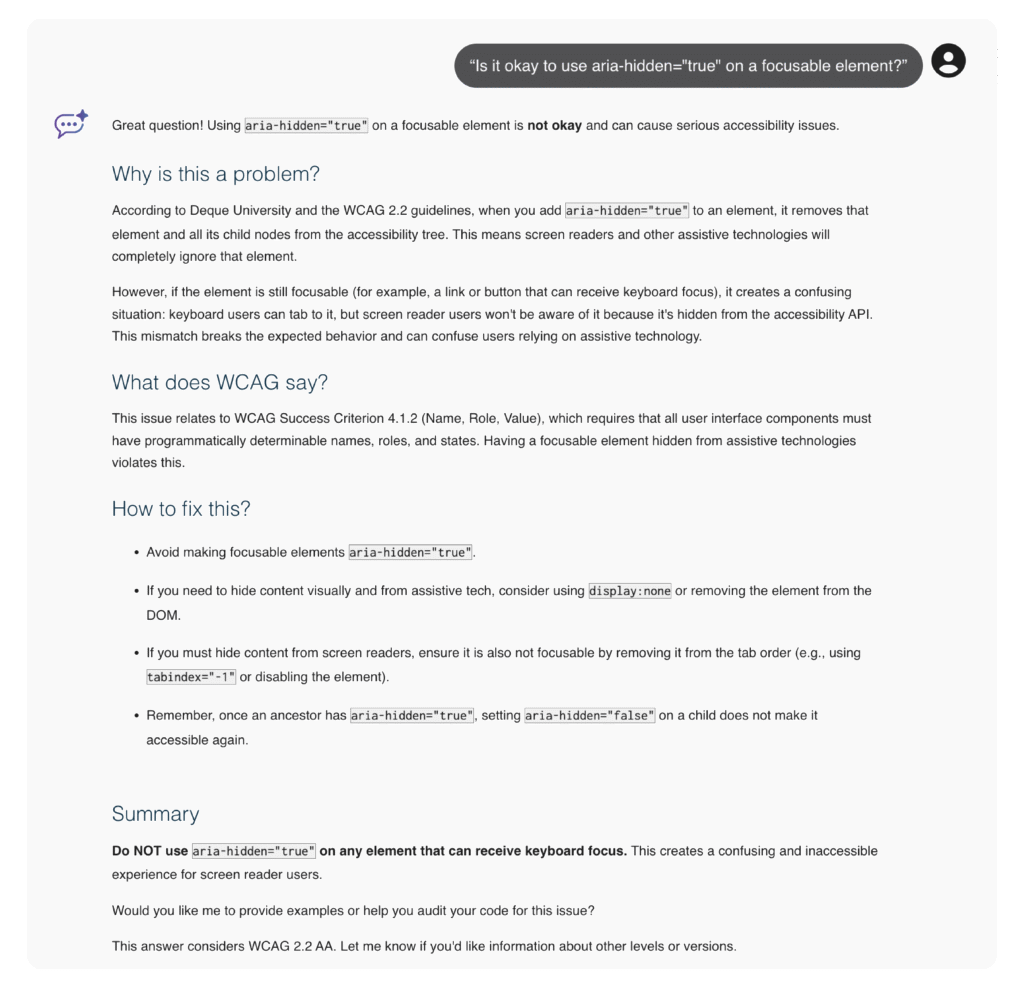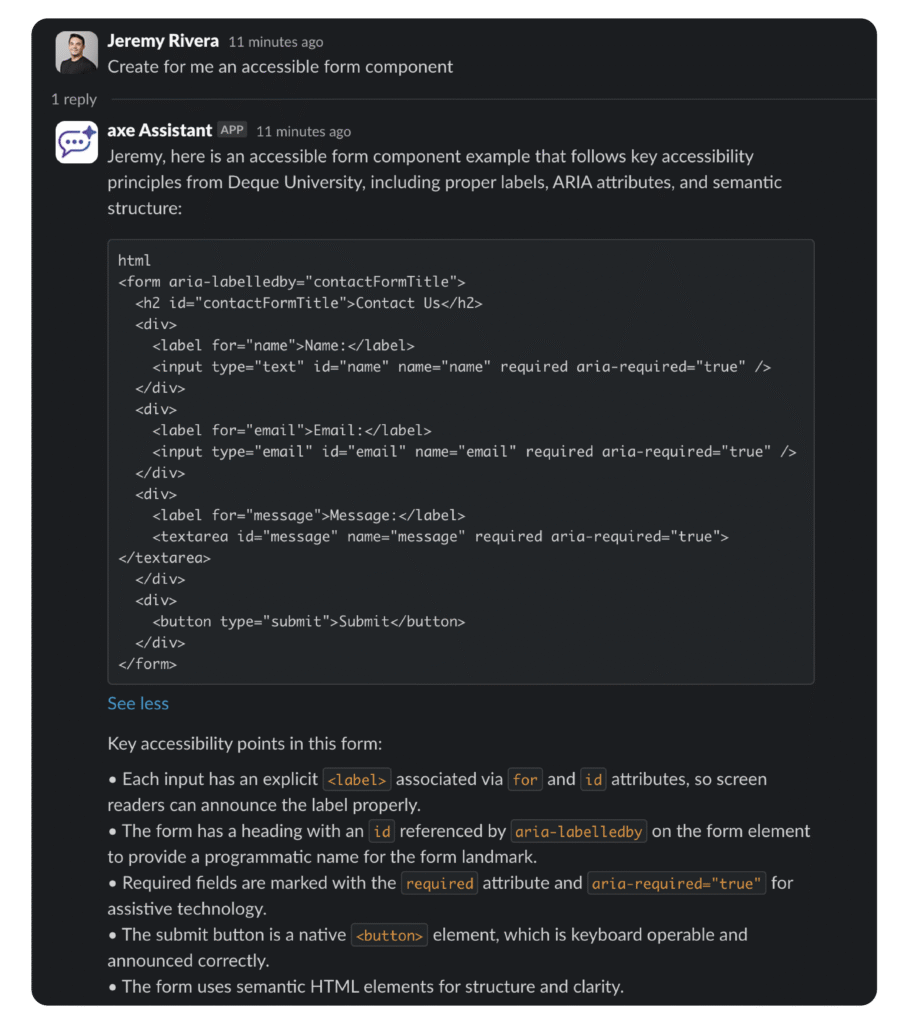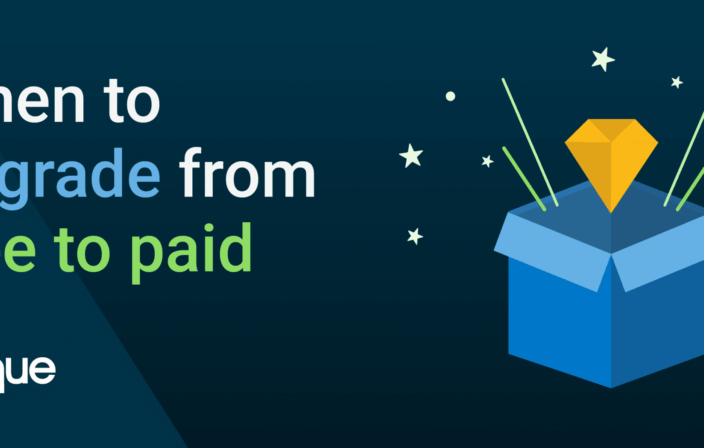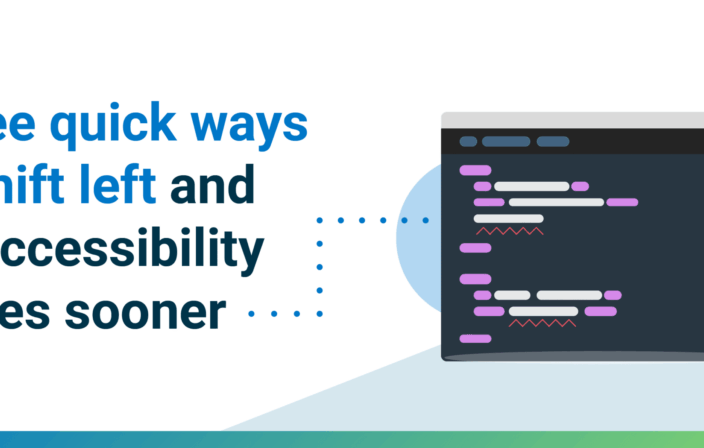Engineering teams today are under pressure to deliver high-quality, accessible code quickly, but these teams often lack an immediate channel to accessibility experts who can validate their work in real time. Without that guidance, issues can slip through that can lead to production delays, costly rework, and broken user experiences.
That’s why having a reliable, expert-backed accessibility resource where developers work is critical. Where can a developer get trustworthy feedback without slowing down? What if they had a tool, trained on the best accessibility knowledge in the industry and validated by the accessibility experts at Deque, to guide them while they code?
To show why this is relevant, let’s take a recent example I’ve seen in the wild.
At one global enterprise, the engineering organization included around 7,000 engineers, with 3,000 of them specifically front-end-focused developers. Based on observed usage patterns, each developer would ask at least one accessibility-related question per quarter. That adds up to more than 12,000 questions annually. Now, with each response taking an average of 20 minutes, that’s over 4,000 hours of valuable engineering time spent just on getting answers. That time could have been spent advancing features, closing tickets, or driving innovation.
Hard to believe, right? But this is the reality for several companies. And these 4,000 hours are only a small part of the story.
Without the right processes in place, many of these web-accessibility questions won’t get asked in the first place. And, not every answer you get may be accurate or verified. This leads to inaccessible code, potential production delays, and expensive rework later in the software development lifecycle (SDLC).
What’s the solution?
Always-on access to trusted digital accessibility guidance right where and when it’s needed. Whether managing a team of engineers or actively writing new code, anyone can turn to axe Assistant for expert support at any moment, directly within their everyday workflow.
A developer’s ally: axe Assistant
Deque’s purpose-built generative AI chatbot for accessibility, axe Assistant, is available where we already collaborate, namely on Slack, Microsoft Teams, or a web browser. Instead of wading through WCAG documentation or waiting on a specialist, you can ask accessibility questions and get quick, easy-to-understand answers without switching contexts or closing tabs. This way, you can continue to stay focused and ship accessible components with confidence.
Think back to the enterprise organization we met at the outset. What if the organization did have an accessibility expert, but that expert was away on a more pressing task or even on vacation? Those 4,000 hours of waiting would increase exponentially, as the developer would have to context switch, leave their flow state, and try to wade through WCAG documentation, or even risk going to an unverified source to find an answer.
Developers can query axe Assistant with relevant questions such as:
“Is it okay to use aria-hidden=”true” on a focusable element?”
Axe Assistant will explain the nuance of your query, citing professional resources such as Deque University, which is the standard in accessibility education:

It’s like having an accessibility expert on standby 24/7, ready and eager to explain the “why” behind the “what” in natural, easy-to-understand language, so you can continue to learn and upskill in web accessibility as you engage with the tool. You may even decide to prompt it with more technical questions involving code, and ask it to return accessible components with semantic markup that you can copy and paste into your text editor. (This is an example using the Slack integration):

Another developer-friendly use case is the Preferences feature (in Slack and Teams), which allows developers to set their specific technical preferences, such as the programming language they’re using. This is a powerful capability that enables developers to receive answers in their preferred language automatically, without needing to specify it each time they prompt the tool. This gives them the ability to easily and confidently get that accessible code to plug into their projects, so you can trust that the code they’re shipping will be accessible.
When deployed at scale, even modest improvements in code quality can translate to significant cost savings and a stronger, more resilient accessibility practice across the organization.
Think back to those 4,000 hours. Not only will developers get their time back from waiting on answers, but they will have the ability to save time on potential rework by shipping a feature that users can actually maneuver. Being proactive in this way, and not reactive (fixing issues after they occur), is an approach that we often call shifting left. I talk about some other ways you can shift left as a developer in this blog.
Continue to scale with axe DevTools
We’ve discussed that by making axe Assistant available to developers, you’re getting immediate value by getting that instant feedback during your workflow that you can implement right away. You’re also laying the foundation for accessible best practices to be implemented in your development organization.
Pairing axe Assistant with the axe DevTools product line gives teams holistic accessibility coverage across the SDLC. Developers can surface accessibility issues as they code and test locally from the browser, while getting expert-backed, context-specific guidance anytime it’s necessary. Developers will continue to stay focused and productive, fixing any accessibility issues with confidence as they stay in their workflow.
Bundling axe Assistant and axe DevTools accelerates issue resolution by closing the accessibility knowledge gap across teams. What once required a dedicated specialist’s review now becomes a moment of learning, enabling everyone from a junior developer to a seasoned engineer to ship accessible code faster.
This tool bundle also supports more complex use cases: Intelligent Guided Tests in axe DevTools Extension reduce manual effort for harder-to-automate scenarios, axe Developer Hub extends visibility into CI/CD pipelines and testing at scale, and axe DevTools for Mobile brings the same level of insight and reliability to native mobile development and testing.
Together, axe Assistant and the axe DevTools product line form a cohesive, end-to-end solution that’s built for developers—and built for scale.
Final takeaway and next steps
With axe Assistant, we’re creating a smarter, more scalable model for accessibility: one that meets your teams where they work and delivers expert help instantly.
Axe Assistant empowers everyone in the development hierarchy by aiming to democratize accessibility—so that anyone, from junior developers to program managers, can carry out their work with reliable guidance. By using axe Assistant you can reduce dependency on a centralized team, shorten your accessibility resolution cycles, and increase accessibility confidence across your organization.
And when paired with axe DevTools, it makes the solutions significantly more powerful. Not only will developers find accessibility issues faster, but they’ll truly understand these issues and be able to fix them at the moment of discovery.
As you grow your digital accessibility program, ensure easy access to expert guidance for your developers. Choose tools that empower them to work quickly and efficiently, while freeing up your subject matter experts to focus on strategic initiatives. You’ll create better, more accessible products, and maximize ROI on your engineering hours. It’s a win for your dev teams and your bottom line.
Learn more about axe Assistant and axe DevTools today and request a demo!




